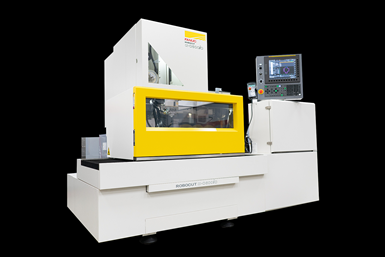Methods Machine Tools Adds New FANUC EDM Models
Methods Machine Tools Inc. added the next generation of the FANUC RoboCut series to its line of wire electrical discharge machining (EDM) products.
Share





Methods Machine Tools Inc., a leading suppliers of machine tools and automation equipment in North America, recently added the FANUC RoboCut α-CiC series to its line of wire electrical discharge machining (EDM) products.
“The α-CiC series continues to push the boundaries of speed, precision, and reliability,” said Steve Raucci, Methods’ technical sales director and RoboCut product manager. “The redesigned α-CiC series creates a faster, more exact EDM experience.”
This generation of the RoboCut is designed for ultimate rigidity. The EDM machines minimize the amount of distortion embedded into each part, according to Methods. New discharge devices, powered by the SF3 power supply, are designed to improve surface roughening capabilities while maintaining high cutting speeds.
According to Methods, additional features include a taper adjustment function for high-precision taper cutting, thermal displacement compensation for increased stability and faster cycle times thanks to the automatic wire feeding system, AWF3, and core stitch technology.
Currently available in two sizes, the RoboCut α-C400iC has travel lengths of 15.748" (400 mm) on the X-axis, 11.811" (300 mm) on the Y-axis and 10.039" (255 mm) on the Z-axis. Travel on the α-C600iC is 23.622" (600 mm), 15.748" (400 mm), and 12.204" (310 mm) on the X-, Y- and Z-axis, respectively.
The new models will replace their respective counterparts in the α-CiB series. The C800iB, which belongs to the previous generation of RoboCut, the α-CiB, is still a part of Methods’ product offering.
Related Content
-
How to Mitigate Chatter to Boost Machining Rates
There are usually better solutions to chatter than just reducing the feed rate. Through vibration analysis, the chatter problem can be solved, enabling much higher metal removal rates, better quality and longer tool life.
-
How to Determine the Currently Active Work Offset Number
Determining the currently active work offset number is practical when the program zero point is changing between workpieces in a production run.
-
The Future of High Feed Milling in Modern Manufacturing
Achieve higher metal removal rates and enhanced predictability with ISCAR’s advanced high-feed milling tools — optimized for today’s competitive global market.

.JPG;width=70;height=70;mode=crop)


















.jpg;maxWidth=300;quality=90)




